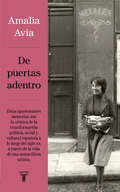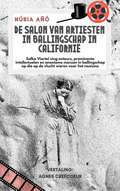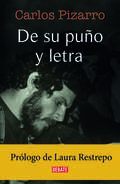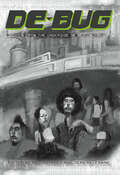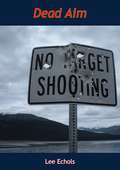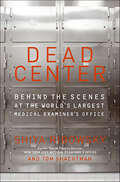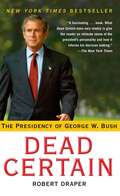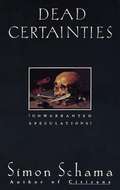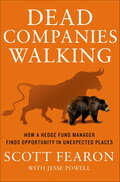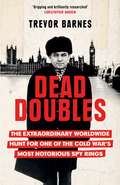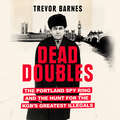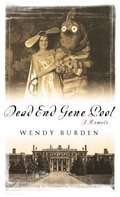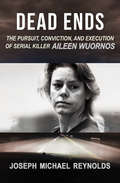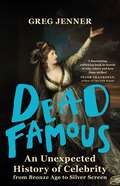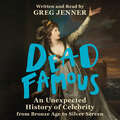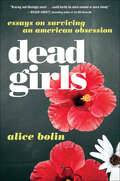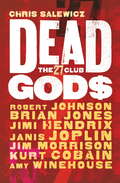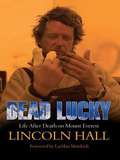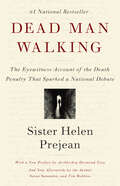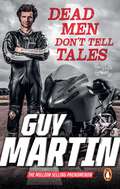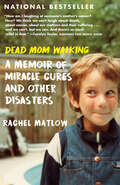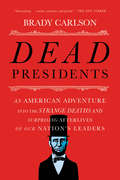- Table View
- List View
De puertas adentro (Memorias Y Biografías/taurus Ser.)
by Amalia AviaEstas apasionantes memorias son la crónica de la transformación política, social y cultural española a lo largo del siglo XX a través de la vida de una maravillosa artista. Amalia Avia, figura esencial en el arte contemporáneo en España, nos abrió en estas memorias las puertas de una vida llena de contrastes, teñida de tonos oscuros pero también de luces brillantes, que se inició en Madrid, a comienzos de los años treinta, en el seno de una familia burguesa. Su primera infancia tuvo el país en guerra como fondo. La posguerra, el luto y los desfiles triunfantes inauguraron un periodo de tristeza y desconcierto y, también, una nueva etapa en el pequeño pueblo manchego en el que pasó diez años. Con firmes pinceladas realistas, la autora retrata el enorme contraste de su vida madrileña y el medio rural en los años cuarenta en el que se desarrolló su adolescencia: el culto a los muertos, los días de costura, iglesia, juegos, lectura y excursiones al monte, la cocina, la cosecha, el ganado, la matanza y las fiestas populares constituyen fascinantes relatos de memoria histórica. La vuelta a Madrid y su formación como pintora en el estudio Peña marcaron un periodo muy fértil. Su relación con otros artistas y escritores, el matrimonio con Lucio Muñoz, sus primeras exposiciones, el Círculo de Bellas Artes, la maternidad, los viajes y la oposición al Régimen marcaron el sendero que culminaría en la apertura del país a la democracia y en la madurez de Amalia Avia como mujer y como pintora. Reseñas:«Amalia Avia logró inscribirse con luz propia en la historia del arte español del siglo XX. Sus memorias no solo son un testimonio precioso sobre su propia vida y la de su generación, sino también la revelación de su rica y compleja intimidad.»Francisco Calvo Serraller, El País «Amalia Avia es la pintora de las ausencias, la amarga cronista del por aquí pasó la vida marcando su amargura e inevitable huella de dolor, como en las novelas de los maestros rusos del XIX.»Camilo José Cela «Amalia Avia fue la cronista melancólica, en grises, de un cierto Madrid de toda la vida, ese Madrid de los portales, de las tiendas antañonas, de las tabernas, de las tascas, de los garajes. Sus memorias son excelentes.»Juan Manuel Bonet «Sus memorias podrían ser un cuadro. Nada extraño si consideramos que su autora es pintora, y de las buenas. Ha elegido la sinceridad que, aliada con la sencillez, traza un retrato no ya de sí misma, sino de una etapa de la vida española que perteneció a muchos que, sin duda, se reconocerán a través de ella.»Trinidad De León-Sotelo, ABC
De salon van artiesten in ballingschap in Californië: Salka Viertel ving acteurs, intellectuelen en anonieme op die op de vlucht waren voor het nazisme
by Núria AñóSalka Viertel ving acteurs, prominente intellectuelen en anonieme mensen in ballingschap op die op de vlucht waren voor het nazisme. Een biografie over Salka Viertel, een Joodse actrice die naar Hollywood emigreerde en in de volksmond bekend werd als de scenarioschrijfster van de Zweedse actrice Greta Garbo. Bovendien had zij een salon in Santa Monica, Californië, die werd bezocht door veel van de Europese intelligentsia in ballingschap. Salka was een zeer moderne en interessante vrouw voor haar tijd, die bekendheid verdient. In het boek komen onderwerpen aan de orde als de vermeende biseksualiteit van Salka Viertel en het aantal bekende vrienden dat zij had, om er maar een paar te noemen: Albert Einstein, Charles Chaplin, Sergei Eisenstein, F.W. Murnau, Max Reinhardt, Arnold Schönberg, Thomas Mann, Bertolt Brecht, Greta Garbo, Montgomery Clift... Ook had zij, net als Gertrude Stein en andere notoire vrouwen, haar eigen literaire salon die bezocht werd door schrijvers als Truman Capote, Christopher Isherwood, Gore Vidal en een lange enzovoort. Andere thema's zijn Berlijn in de jaren 1920; de overgang van stomme films naar de geluidsfilms, gezien vanuit het Mekka van Hollywood. Dan is er de opkomst van Hitler en wat dat betekende voor de Joden; de ballingschap van die intellectuelen die niet naar hun land konden terugkeren vanwege de Tweede Wereldoorlog. Later, de Koude Oorlog en de heksenjacht tegen het communisme. Het is duidelijk dat het leven van Salka Viertel en haar vriendenkring zich afspeelt tegen de achtergrond van de grote gebeurtenissen van de 20e eeuw. Met dit project verkreeg de auteur de beurzen van het Shanghai Writing Program (China, 2016) en het Baltic Centre (Zweden, 2017). "Een zeer interessant verhaal en ik denk zelfs in deze tijd zeer actueel, want in mijn ogen hebben we niet veel vooruitgang geboekt op het punt van de acceptatie van "intermenselijke gevoelens" in het algemeen. Een geweldig en zeer interessant boek over Hollywoo
De su puño y letra
by Carlos Pizarro"En estas cartas entregaré al hombre que sobrepasó mil veces misexpectativas, por ser tan solo eso, un hombre, pero uno perseverante enla construcción de sus sueños, un hombre que, enamorado de la libertad,se le rebeló a la misma rebeldía y fue capaz de romper sus propiosesquemas. Ese es el padre que descubrí. #en estas cartas él está vivo ypresente, quien habla es Carlos Pizarro, conocido y recordado por muchosdesde la distancia de los tiempos, quien a pesar de despertar odios osimpatías, pocas personas conocen. Aquí podrán encontrarlo luchando ensu empeño por darle un nuevo sentido a su país, intentando cambiarle elrumbo, enfrentando sus fantasmas y demonios, tratando de interpretar alser humano, de retornarle dignidad al humilde, al desposeído y, en suoficio, mitigar las desdichas del prójimo, sufriendo por losperseguidos, para convertirse finalmente en uno de ellos". María JoséPizarro
De su puño y letra
by Carlos PizarroLas conmovedoras y hermosas cartas que Carlos Pizarro envió a su esposay a su hija "En estas cartas entregaré al hombre que sobrepasó mil veces misexpectativas, por ser tan solo eso, un hombre, pero uno perseverante enla construcción de sus sueños, un hombre que, enamorado de la libertad,se le rebeló a la misma rebeldía y fue capaz de romper sus propiosesquemas. Ese es el padre que descubrí. #en estas cartas él está vivo ypresente, quien habla es Carlos Pizarro, conocido y recordado por muchosdesde la distancia de los tiempos, quien a pesar de despertar odios osimpatías, pocas personas conocen. Aquí podrán encontrarlo luchando ensu empeño por darle un nuevo sentido a su país, intentando cambiarle elrumbo, enfrentando sus fantasmas y demonios, tratando de interpretar alser humano, de retornarle dignidad al humilde, al desposeído y, en suoficio, mitigar las desdichas del prójimo, sufriendo por losperseguidos, para convertirse finalmente en uno de ellos". María JoséPizarro
De-Bug: Voices from the Underside of Silicon Valley
by Raj Jayadev and Jean MelesaineStories of the dot-com boom—from everyone but the techies. “A raw look into the lives of residents bearing the brunt of gentrification.” —HuffPostNo shuttle buses here: De-Bug, a new collection of true stories from the social justice organization of the same name, shows a side of working in Silicon Valley that you won’t read about in the business section. As tech moguls land the cover of Forbes, the South Bay’s working class is making ends meet as metal scrappers, factory workers, club bouncers, hairstylists, rickshaw drivers, ice cream cart pushers. The stories in De-Bug are poignant, often very funny accounts of bootstrapping in the land of angel investors and thought leaders. A construction worker predicts which of his customers are about to strike it rich and which are on the edge of bankruptcy based on the states of their swimming pools. A “secondhand hustler” travels the garage sale-flea market circuit in search of treasures to resell online. A temp worker at a medical device manufacturer sells his blood, at the company’s request, to test the equipment. These storytellers are frank when discussing their own flaws, but are equally up-front about the rigged system in which they operate.Disruptive in the truest sense of the word, De-Bug offers valuable insight into California’s latest boomtown.“Silicon Valley’s less-noticed denizens show an unexpected knack for grace, wit, and survival.” —Kentaro Toyama, author of Geek Heresy“If you truly want to know Silicon Valley, in all of its complexity, then De-Bug is a must-read.” —Tomás Jiménez, associate professor of sociology, Stanford University
Dead Aim
by Lee EcholsFirst published in 1951, this book recounts the nostalgic antics of hell-raising pistol shooters of the 1930’s.It is complete and unexpurgated and is the hot blasts of mirth from the shaky guns of Lee Echols, who fired for many years before World War II with the U.S. Treasury Department Pistol Team.Lee Echols’ stock-in-trade was the business of making a pistol go whangety-bang with a fair degree of accuracy. However, this always had to take a back seat to his hell-raising antics and inspired tom-foolery, which had him known as the Clown Prince of pistoleers on every range in the Western Hemisphere.
Dead Center: Behind the Scenes at the World's Largest Medical Examiner's Office
by Shiya Ribowsky Tom ShachtmanThis insider’s account of the NYC medical examiner’s office takes readers from an average day in the autopsy room to the tragic aftermath of 9/11.For fifteen years, Shiya Ribowsky worked as a medicolegal investigator in New York City’s medical examiner’s office—the largest, most sophisticated organization of its kind in the world. Ribowsky led the investigations of more than eight thousand individual deaths, becoming a key figure in some of New York’s most bizarre death cases. He also took charge of the largest forensic investigation ever attempted: identifying the dead in the aftermath of September 11th.Now Ribowsky pulls back the curtain on the New York City’s medical examiner’s office, giving a never-before-seen glimpse into death and the city. From vermin-infested Bowery flophouses to posh Upper East Side apartments of the city’s dead, Ribowsky explores the skeletons that hang in the Big Apple’s closets. Combing through the autopsy room, he also exposes the grim secrets that only a scalpel can reveal, and explains how forensic investigation not only solve crimes—but also saves lives.
Dead Certain: The Presidency of George W. Bush
by Robert DraperIn this ambitious work of political narrative, Robert Draper takes us inside the Bush White House and delivers an intimate portrait of a tumultuous decade and a beleaguered administration. Virtually every page of this book crackles with scenes, anecdotes, and dialogue that will surprise even long- time observers of George W. Bush. With unprecedented access to all the key figures of this administration -- from six one-on-one sessions with the president, to Laura Bush, Dick Cheney, Donald Rumsfeld, Condoleeza Rice, Karl Rove, and perhaps 200 other players, some well-known, some not -- Draper has achieved what no other journalist or contemporary historian has done thus far: he has told the story of the Bush White House from the inside, with a special emphasis on how the very personality of this strong-willed president has affected the outcome of events. Bush loyalists and the growing number of Bush detractors will all find much to savor in this riveting political page-turner. We begin with a revealing lunch at the White House where a testy, hot dog-chomping president finally unburdens himself to the inquisitive reporter, a fellow Texan who well understands the manly argot that courses through this administration. We revisit the primaries of election-year 2000, in which the character of the candidate and indeed the future of the Republican Party were forged in the scalding South Carolina battle with Senator John McCain. We proceed forward to witness intimately the confusion and the eloquence that followed the September 11 attacks, then the feckless attempts to provide electricity to a darkened Baghdad, the high- and lowlights of the 2004 re-election bid, the startling and fruitless attempt to "spend capital" by overhauling the Social Security system, the inept response to Katrina, the downward spiraling and increasingly divisive war in Iraq. Though the headlines may be familiar, the details, the utterly inside account of how events transpired will come as fresh reportage to even the most devoted followers of mainstream media coverage. In this most press- wary of administrations, Robert Draper has accomplished a small miracle: He has knocked on all on the right doors, and thus become the first author to tell a personality-driven history of the Bush years. In so doing, he allows us to witness in complete granularity the personal force of a president determined to achieve big things, who remained an optimist in the face of a sometimes harsh unpopularity, who confronted the history of his time with what can surely be described as dead certainty.
Dead Certainties: Unwarranted Speculations
by Simon SchamaDead Certainties goes beyond more conventional histories to address the deeper enigmas that confront a student of the past. In order to do so, Schama reconstructs -- and at times reinvents -- two ambiguous deaths, that of General James Wolfe in 1759 and George Parkman in 1849.
Dead Companies Walking: How a Hedge Fund Manager Finds Opportunity in Unexpected Places
by Scott Fearon Jesse PowellA hedge fund manager reveals how to spot a business on the verge of collapse—and how to profit from it—in this “surprisingly entertaining” guide (Publishers Weekly).Unlike most investors, who live in fear of failure, Scott Fearon actively seeks it out. He has earned millions of dollars for his hedge fund by shorting the stocks of businesses he believed were on their way to bankruptcy. In Dead Companies Walking, Fearon describes his methods for spotting these doomed businesses, and how they can be extremely profitable investments.In his experience, corporate managers routinely commit six common mistakes that can derail even the most promising companies: they learn from only the recent past; they rely too heavily on a formula for success; they misunderstand their target customers; they fall victim to the magical storytelling of a mania; they fail to adapt to tectonic shifts in their industry; and they are physically or emotionally removed from their companies’ operations.Fearon has interviewed thousands of executives across America, many of whom, unknowingly, were headed toward bankruptcy—from the Texas oil barons of the 80s to the tech wunderkinds of the late 90s to the flush real estate developers of the mid-2000s. Here, he explores recent examples like JC Penney, Herbalife, and Blockbuster Entertainment to help investors better predict the next booms and busts—and come out on top.
Dead Doubles: The Extraordinary Worldwide Hunt for One of the Cold War's Most Notorious Spy Rings
by Trevor BarnesTHE PORTLAND SPY RING was one of the most infamous espionage cases from the Cold War. People the world over were shocked when its exposure revealed the shadowy world of deep cover KGB 'illegals' - spies operating under false identities stolen from the dead.The CIA's revelation to MI5 in 1960 that a KGB agent was stealing crucial secrets from the world-leading submarine research base at Portland in Dorset looked initially like a dangerous but contained lapse of security by a British man and his mistress. But the couple were tailed by MI5 'watchers' to a covert meeting with a Canadian businessman, Gordon Lonsdale. The unsuspecting Lonsdale in turn led MI5's spycatchers to an innocent-looking couple in suburban Ruislip called the Krogers.But within weeks the CIA rang the alarm - their critical source of intelligence was to defect within hours - and MI5 was forced to act immediately. The Krogers were exposed as two of the most important Russian 'illegals' ever, whom the Americans had been hunting for years. And Lonsdale was no Canadian, but a senior KGB controller.This astonishing but true story of MI5's spyhunt is straight from the world of John le Carré and is told here for the first time using hitherto secret MI5 and FBI files, private family archives and original interviews. Its tentacles stretch around the world - from America, to the USSR, Canada, New Zealand, Europe and the UK. DEAD DOUBLES is a gripping episode of Cold War history, and a case that fully justified the West's paranoia about infiltration and treachery.
Dead Doubles: The Extraordinary Worldwide Hunt for One of the Cold War's Most Notorious Spy Rings
by Trevor BarnesTHE PORTLAND SPY RING was one of the most infamous espionage cases from the Cold War. People the world over were shocked when its exposure revealed the shadowy world of deep cover KGB 'illegals' - spies operating under false identities stolen from the dead.The CIA's revelation to MI5 in 1960 that a KGB agent was stealing crucial secrets from the world-leading submarine research base at Portland in Dorset looked initially like a dangerous but contained lapse of security by a British man and his mistress. But the couple were tailed by MI5 'watchers' to a covert meeting with a Canadian businessman, Gordon Lonsdale. The unsuspecting Lonsdale in turn led MI5's spycatchers to an innocent-looking couple in suburban Ruislip called the Krogers.But within weeks the CIA rang the alarm - their critical source of intelligence was to defect within hours - and MI5 was forced to act immediately. The Krogers were exposed as two of the most important Russian 'illegals' ever, whom the Americans had been hunting for years. And Lonsdale was no Canadian, but a senior KGB controller.This astonishing but true story of MI5's spyhunt is straight from the world of John le Carré and is told here for the first time using hitherto secret MI5 and FBI files, private family archives and original interviews. Its tentacles stretch around the world - from America, to the USSR, Canada, New Zealand, Europe and the UK. DEAD DOUBLES is a gripping episode of Cold War history, and a case that fully justified the West's paranoia about infiltration and treachery.
Dead End Gene Pool
by Wendy BurdenIn the tradition of Sean Wilsey's Oh the Glory of It All and Augusten Burroughs's Running with Scissors, the great-great-great-granddaughter of Cornelius Vanderbilt gives audiences a grand tour of the world of wealth and WASPish peculiarity, in her irreverent and darkly humorous memoir.
Dead Ends: The Pursuit, Conviction, and Execution of Serial Killer Aileen Wuornos
by Joseph Michael ReynoldsThe chilling true story of female serial killer Aileen Wuornos, whose violent crimes shocked the nation--and inspired the Academy Award-winning film Monster. When police in Florida's Volusia County were called to investigate the murder of Richard Mallory, whose gunshot-ridden body had been found in the woods just north of Daytona Beach in December 1989, their search led them to a string of dead ends before the trail went cold six months later. During the spring and summer of 1990, the bodies of six more middle-aged white men were discovered--all in secluded areas near their abandoned vehicles, all but one shot dead with a .22 caliber pistol--and all without any suspects, motives, or leads. The police speculated that the murders were connected, but they never anticipated what they'd soon discover: The killings were the work of a single culprit, Aileen Wuornos, one of the first women to ever fit the profile of a serial killer. With the cooperation of her former lover and accomplice, Tyria Moore, the police were able to solicit a confession from Wuornos about her months-long killing spree along Florida's interstate highways. The nation was quickly swept up in the drama of her trial and the media dubbed her the "Damsel of Death" as horrifying details of her past as a prostitute and drifter emerged. Written by the Reuters reporter who initially broke the story, Dead Ends is a thrilling firsthand account of Wuornos's capture, trial, and ultimate sentencing to death by lethal injection, that goes beyond the media frenzy to reveal the even more disturbing truth.
Dead Famous: An Unexpected History of Celebrity from Bronze Age to Silver Screen
by Greg JennerDuring these extraordinary times Greg Jenner is able to sign you a personalised bookplate for your hardback. Please email info@gregjenner.com with the name you would like the book dedicated to and the postal address. 'Fizzes with clever vignettes and juicy tidbits... [a] joyous romp of a book.' Guardian'A magical mystery tour through the history of celebrity - eye opening, provocative, triumphant.' Kate Williams, bestselling author and historian'A fascinating, rollicking book in search of why, where and how fame strikes. Sit back and enjoy the ride.' Peter FrankopanCelebrity, with its neon glow and selfie pout, strikes us as hypermodern. But the famous and infamous have been thrilling, titillating, and outraging us for much longer than we might realise. Whether it was the scandalous Lord Byron, whose poetry sent female fans into an erotic frenzy; or the cheetah-owning, coffin-sleeping, one-legged French actress Sarah Bernhardt, who launched a violent feud with her former best friend; or Edmund Kean, the dazzling Shakespearean actor whose monstrous ego and terrible alcoholism saw him nearly murdered by his own audience - the list of stars whose careers burned bright before the Age of Television is extensive and thrillingly varied. Celebrities could be heroes or villains; warriors or murderers; brilliant talents, or fraudsters with a flair for fibbing; trendsetters, wilful provocateurs, or tragic victims marketed as freaks of nature. Some craved fame while others had it forced upon them. A few found fame as small children, some had to wait decades to get their break. But uniting them all is the shared origin point: since the early 1700s, celebrity has been one of the most emphatic driving forces in popular culture; it is a lurid cousin to Ancient Greek ideas of glorious and notorious reputation, and its emergence helped to shape public attitudes to ethics, national identity, religious faith, wealth, sexuality, and gender roles. In this ambitious history, that spans the Bronze Age to the coming of Hollywood's Golden Age, Greg Jenner assembles a vibrant cast of over 125 actors, singers, dancers, sportspeople, freaks, demigods, ruffians, and more, in search of celebrity's historical roots. He reveals why celebrity burst into life in the early eighteenth century, how it differs to ancient ideas of fame, the techniques through which it was acquired, how it was maintained, the effect it had on public tastes, and the psychological burden stardom could place on those in the glaring limelight. DEAD FAMOUS is a surprising, funny, and fascinating exploration of both a bygone age and how we came to inhabit our modern, fame obsessed society.
Dead Famous: An Unexpected History of Celebrity from Bronze Age to Silver Screen
by Greg Jenner'Fizzes with clever vignettes and juicy tidbits... [a] joyous romp of a book.' Guardian'A magical mystery tour through the history of celebrity - eye opening, provocative, triumphant.' Kate Williams, bestselling author and historian'A fascinating, rollicking book in search of why, where and how fame strikes. Sit back and enjoy the ride.' Peter FrankopanCelebrity, with its neon glow and selfie pout, strikes us as hypermodern. But the famous and infamous have been thrilling, titillating, and outraging us for much longer than we might realise. Whether it was the scandalous Lord Byron, whose poetry sent female fans into an erotic frenzy; or the cheetah-owning, coffin-sleeping, one-legged French actress Sarah Bernhardt, who launched a violent feud with her former best friend; or Edmund Kean, the dazzling Shakespearean actor whose monstrous ego and terrible alcoholism saw him nearly murdered by his own audience - the list of stars whose careers burned bright before the Age of Television is extensive and thrillingly varied. Celebrities could be heroes or villains; warriors or murderers; brilliant talents, or fraudsters with a flair for fibbing; trendsetters, wilful provocateurs, or tragic victims marketed as freaks of nature. Some craved fame while others had it forced upon them. A few found fame as small children, some had to wait decades to get their break. But uniting them all is the shared origin point: since the early 1700s, celebrity has been one of the most emphatic driving forces in popular culture; it is a lurid cousin to Ancient Greek ideas of glorious and notorious reputation, and its emergence helped to shape public attitudes to ethics, national identity, religious faith, wealth, sexuality, and gender roles. In this ambitious history, that spans the Bronze Age to the coming of Hollywood's Golden Age, Greg Jenner assembles a vibrant cast of over 125 actors, singers, dancers, sportspeople, freaks, demigods, ruffians, and more, in search of celebrity's historical roots. He reveals why celebrity burst into life in the early eighteenth century, how it differs to ancient ideas of fame, the techniques through which it was acquired, how it was maintained, the effect it had on public tastes, and the psychological burden stardom could place on those in the glaring limelight. DEAD FAMOUS is a surprising, funny, and fascinating exploration of both a bygone age and how we came to inhabit our modern, fame obsessed society.
Dead Famous: An Unexpected History of Celebrity from Bronze Age to Silver Screen
by Greg Jenner'Fizzes with clever vignettes and juicy tidbits... [a] joyous romp of a book.' Guardian'A fascinating, rollicking book in search of why, where and how fame strikes. Sit back and enjoy the ride.' Peter Frankopan, author of The Silk Roads'[An] engaging and well-researched book... Jenner brings his material to vivid life' ObserverCelebrity, with its neon glow and selfie pout, strikes us as hypermodern. But the famous and infamous have been thrilling, titillating, and outraging us for much longer than we might realise. Whether it was the scandalous Lord Byron, whose poetry sent female fans into an erotic frenzy; or the cheetah-owning, coffin-sleeping, one-legged French actress Sarah Bernhardt, who launched a violent feud with her former best friend; or Edmund Kean, the dazzling Shakespearean actor whose monstrous ego and terrible alcoholism saw him nearly murdered by his own audience - the list of stars whose careers burned bright before the Age of Television is extensive and thrillingly varied. In this ambitious history, that spans the Bronze Age to the coming of Hollywood's Golden Age, Greg Jenner assembles a vibrant cast of over 125 actors, singers, dancers, sportspeople, freaks, demigods, ruffians, and more, in search of celebrity's historical roots. He reveals why celebrity burst into life in the early eighteenth century, how it differs to ancient ideas of fame, the techniques through which it was acquired, how it was maintained, the effect it had on public tastes, and the psychological burden stardom could place on those in the glaring limelight. DEAD FAMOUS is a surprising, funny, and fascinating exploration of both a bygone age and how we came to inhabit our modern, fame obsessed society.
Dead Girls: Essays on Surviving an American Obsession
by Alice Bolin“[A] deliciously dry, moody essay collection” about America’s obsession with violence against women is “a lyrical meditation” (Carina Chocano, New York Times Book Review).In this poignant collection, Alice Bolin examines iconic American works from the essays of Joan Didion and James Baldwin to Twin Peaks, Britney Spears, and Serial, illuminating the widespread obsession with women who are abused, killed, and disenfranchised, and whose bodies (dead and alive) are used as props to bolster men’s stories. Smart and accessible, thoughtful and heartfelt, Bolin investigates the implications of our cultural fixations, and her own role as a consumer and creator.Bolin chronicles her life in Los Angeles, dissects the Noir, revisits her own coming of age, and analyzes stories of witches and werewolves, both appreciating and challenging the narratives we construct and absorb every day. Dead Girls begins by exploring the trope of dead women in fiction, and ends by interrogating the more complex dilemma of living women – both the persistent injustices they suffer and the oppression that white women help perpetrate.“Bracing and blazingly smart.” —Megan Abbott, Edgar Award–winning author of You Will Know Me“The cultural criticism serves to help us all think a little bit more about what we’re consuming—and who’s being damaged by it.” —Entertainment Weekly“[A] sharp-eyed book of essays.” —Washington Post“Wise and wonderful.” —Robin Wasserman, author of Girls on Fire“Engrossing . . . eerily enthralling, systematically on point, and quite funny . . . An illuminating study on the role women play in the media and in their own lives.” —Kirkus Reviews (starred review)“Smart, thorough, and urgent, Bolin’s essays are a force to be reckoned with.” —Booklist
Dead Gods: The 27 Club
by Chris SalewiczRobert Johnson. Brian Jones. Jimi Hendrix. Janis Joplin. Jim Morrison. Kurt Cobain. Amy Winehouse. They were inspirational, controversial, talismanic and innovative. They lead lives full of myth, scandal, sex, drugs and some of the most glorious music that has ever heard. Though each of their lives were cut tragically short at the age of 27, they would all leave the world having changed it irrevocably. Chris Salewicz tells, in intimate detail, the stories behind these compelling figures. From Robert Johnson and his legendary deal with the devil, to Jimi Hendrix appearing like a psychedelic comet on the London scene, through to Amy Winehouse's blazing talent and her savage appetite for self-destruction.
Dead Gods: The 27 Club
by Chris SalewiczRobert Johnson. Brian Jones. Jimi Hendrix. Janis Joplin. Jim Morrison. Kurt Cobain. Amy Winehouse. They were inspirational, controversial, talismanic and innovative. They lead lives full of myth, scandal, sex, drugs and some of the most glorious music that has ever heard. Though each of their lives were cut tragically short at the age of 27, they would all leave the world having changed it irrevocably. Chris Salewicz tells, in intimate detail, the stories behind these compelling figures. From Robert Johnson and his legendary deal with the devil, to Jimi Hendrix appearing like a psychedelic comet on the London scene, through to Amy Winehouse's blazing talent and her savage appetite for self-destruction.
Dead Lucky: Life After Death on Mount Everest
by Lincoln HallLincoln Hall's breathtaking account of surviving a night in Everest's "death zone."Lincoln Hall likes to say that on the evening of May 25, 2006, he died on Everest. Indeed, Hall attempted to climb the mountain during a deadly season in which eleven people perished. And he was, in fact, pronounced dead, after collapsing from altitude sickness. Two Sherpas spent hours trying to revive him, but as darkness fell, word came via radio from the expedition's leader that they should descend in order to save themselves. The news of Hall's death traveled rapidly from mountaineering websites to news media around the world, and ultimately to his family back in Australia. Early the next morning, however, an American guide, climbing with two clients and a Sherpa, was startled to find Hall sitting cross-legged on a sharp crest of the summit ridge. In this page-turning account of survival against all odds, Hall chronicles in fascinating detail the days and nights that led up to his fateful night in Mount Everest's "death zone." His story is all the more miraculous given his climbing history. Hall had been part of Australia's first attempt to reach the top of Everest in 1984 but had not done any major climbing for many years, having set aside his passion in order to support his family. While others in the team achieved their dream during this 1984 expedition, Hall was forced to turn back due to illness. Thus, his triumph in reaching the summit at the age of fifty is a story unto itself. So, too, is Hall's description of his family's experience back in Australia, as sudden grief turned to relief and joy in a matter of hours. Rarely has there been such a thrilling narrative of one man's encounter with the world's tallest mountain.
Dead Man Walking: The Eyewitness Account of the Death Penalty That Sparked a National Debate (Shooting Script Ser.)
by Helen Prejean#1 NATIONAL BESTSELLER • A profoundly moving spiritual journey through our system of capital punishment and an unprecedented look at the human consequences of the death penalty • "Stunning moral clarity.&” —The Washington Post Book World • Basis for the award-winning major motion picture starring Susan Sarandon and Sean Penn"Sister Prejean is an excellent writer, direct and honest and unsentimental. . . . She almost palpably extends a hand to her readers.&” —The New York Times Book Review In 1982, Sister Helen Prejean became the spiritual advisor to Patrick Sonnier, the convicted killer of two teenagers who was sentenced to die in the electric chair of Louisiana&’s Angola State Prison. In the months before Sonnier&’s death, the Roman Catholic nun came to know a man who was as terrified as he had once been terrifying. She also came to know the families of the victims and the men whose job it was to execute—men who often harbored doubts about the rightness of what they were doing.Out of that dreadful intimacy comes a profoundly moving spiritual journey through our system of capital punishment. Here Sister Helen confronts both the plight of the condemned and the rage of the bereaved, the fears of a society shattered by violence and the Christian imperative of love. On its original publication in 1993, Dead Man Walking emerged as an unprecedented look at the human consequences of the death penalty. Now, some two decades later, this story—which has inspired a film, a stage play, an opera and a musical album—is more gut-wrenching than ever, stirring deep and life-changing reflection in all who encounter it.
Dead Men Don't Tell Tales
by Guy MartinGuy Martin can't sit still. He has to keep pushing - both himself and whatever machine he is piloting - to the extreme. He's a doer, not a talker.That applies whether Guy's competing in a self-supported 750-mile mountain bike race across Arizona, or trying to reach 300mph in a standing mile on the 800-horsepower motorbike he built in his shed. And during his TV adventures, travelling through Japan, winning records for the world's fastest tractor, re-creating the famous Steve McQueen Great Escape jump, discovering the toil and sacrifice of the D-Day landings and trying to cut the mustard as a Battle of Britain pilot.Guy's become a dad now and he's hoping that one day his daughter will grow up to be a better welder than he is. Oh, and he's still getting up at 5am to work on trucks in for service or to be out on his tractor, working the Lincolnshire land he's always called home.This is Guy Martin's latest book, in his own words, on the last four years of his life that make the rest of us look like we're in slow motion.We're here for a good time, not a long time. To Guy, if it's worth doing, it's worth dying for.
Dead Mom Walking: A Memoir of Miracle Cures and Other Disasters
by Rachel Matlow"How am I laughing at someone's mother's cancer? How? We think we can't laugh about death, about cancer, about our mothers and their suffering . . . and we can't, but we can. And there's so much relief in that. I laughed, I cried, I laughed and laughed and laughed."--Carolyn Taylor, BARONESS VON SKETCH SHOWA traumedy about life and death (and every cosmic joke in between)When her mother is diagnosed with cancer, Rachel Matlow is concerned but hopeful. It's Stage 1, so her mom will get surgery and everything will go back to normal. But growing up in Rachel's family, there was no normal. Elaine, an alternative school teacher and self-help junkie, was never a capital M "Mommy"--she spent more time meditating than packing lunches--and Rachel, who played hockey with the boys and refused to ever wear a dress, was no ordinary daughter.When Elaine decides to forgo conventional treatment and heal herself naturally, Rachel is forced to ponder whether the very things that made her mom so special--her independent spirit, her belief in being the author of her own story--are what will ultimately kill her. As the cancer progresses, so does Elaine's conviction in doing things her way. She assembles a dream team of alternative healers, gulps down herbal tinctures with every meal, and talks (with respect) to her cancer cells. Anxious and confused, Rachel is torn between indulging her pie-in-the-sky pursuits (ayahuasca and all) and pleading with the person who's taking her mother away.With irreverence and honesty--and a little help from Elaine's journals and self-published dating guide, plus hours of conversations recorded in her dying days--Matlow brings her inimitable mother to life on the page. Dead Mom Walking is the hilarious and heartfelt story of what happens when two people who've always written their own script go head to head with each other, and with life's least forgiving plot device.
Dead Presidents: An American Adventure into the Strange Deaths and Surprising Afterlives of Our Nation’s Leaders
by Brady CarlsonAn entertaining exploration into the death stories of our nation’s greatest leaders—and the wild ways we choose to remember and memorialize them. To public radio host and reporter Brady Carlson, the weighty responsibilities of being president never end. As Carlson sees it, the dead presidents (and the ways we remember them) tell us a great deal about ourselves, our history, and how we imagine our past and future. For American presidents, there is life after death—it’s just a little weird. In Dead Presidents, Carlson takes readers on an epic trip to presidential gravesites, monuments, and memorials from sea to shining sea. With an engaging mix of history and contemporary reporting, Carlson recounts the surprising origin stories of the Washington Monument, Mount Rushmore, Grant’s Tomb, and JFK’s Eternal Flame. He explores whether William Henry Harrison really died of a cold, how the assassin’s bullet may not have been what killed James A. Garfield, and why Zachary Taylor’s remains were exhumed 140 years after he died. And he explains the strange afterlives of the presidents, including why “Hooverball” is still played in Iowa, why Millard Fillmore’s final resting place is next to that of funk legend Rick James, why “Who’s buried in Grant’s Tomb?” became a running gag for Groucho Marx, why Ohio and Alaska fought for so long over the name of Mt. McKinley (now known as Denali), and why we exalt dead presidents not just with public statues and iconic paintings but with kitschy wax dummies, Halloween costumes, and bobblehead dolls. With an infectious passion for history and an eye for neglected places and offbeat characters reminiscent of Tony Horwitz and Sarah Vowell, Carlson shows that the ways we memorialize our presidents reveal as much about us as it does about the men themselves.
